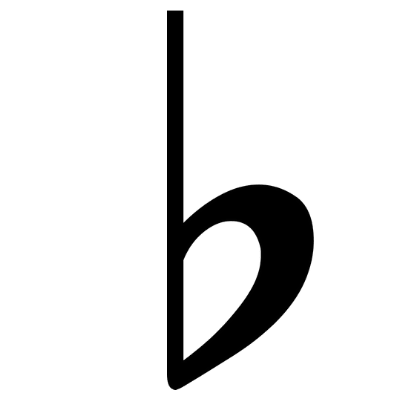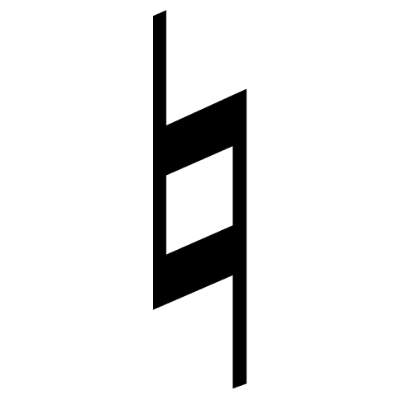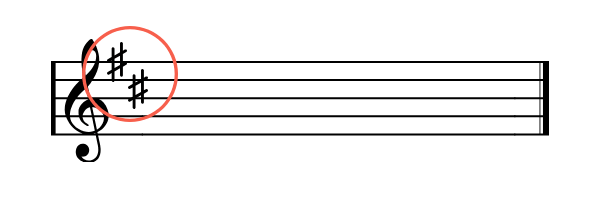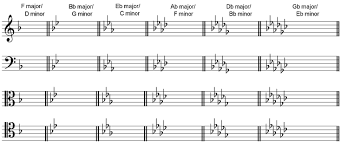What Are Key Signatures?
Key signatures tell you what key a piece of music is in. A key signature is simply a set of sharps or flats written at the beginning of the music that applies throughout a section of music.
More specifically, a key signature is a collection of accidentals (sharp and flat symbols) that let you know what key the music is in. These accidentals apply throughout the entirety of the piece unless otherwise noted by a change in key signature or with new accidentals attached to a note.
In Western music, key signatures are based on the major and minor key system. Every key signature tells you whether the piece is in a major or a minor key and which notes are altered.
A key signature is placed immediately after the clef at the beginning of the staff. This placement never changes. No matter the instrument or clef, key signatures are always placed at the beginning of the music, right after the clef symbol.
Understanding how key signatures work is essential for reading music fluently and identifying the key of the music quickly.
Accidentals in a Key Signature
A flat sign looks like this:

When you see a flat, you lower the pitch by a half step.
A sharp sign looks like this:

This symbol means you raise the pitch by a half step.
A natural sign looks like this:

A natural cancels any previous sharp or flat and tells you to play the pitch without modification.
A key signature will only contain one kind of accidental, either sharps or flats, but never both. Because of this, we often describe keys as either sharp keys or flat keys.
Flats in a key signature apply to every octave of that note. If the key has flats in the key, every occurrence of that note is lowered unless canceled. The same is true for sharps.
Key signatures are placed at the beginning of the staff and apply throughout the piece in the key unless a new key signature appears.
Order of Sharps and Flats
Accidentals in key signatures are always written in the same order. This is known as the order of sharps and flats.

Sharps are written in this order:
F, C, G, D, A, E, B
Flats are written in this order:
B, E, A, D, G, C, F
Memorizing the order of sharps and remembering the order of flats makes it much easier to identify different keys quickly. This pattern continues consistently through every major key and minor key.
For example, the key of G has one sharp, F-sharp. The key of D major has two sharps, F-sharp and C-sharp. Each successive key adds one sharp following the same order.
This pattern is one of the reasons key signatures are so predictable and easy to learn once you understand the system.
All Key Signatures
Below is a key signature chart showing the number of sharps or flats in each major and minor key. Major keys are written with capital letters. Minor key signatures are written with lowercase letters.
| Number of Accidentals | Major Key | Minor Key |
|---|---|---|
| No sharps or flats | C Major | a minor |
| One flat | F Major | d minor |
| Two flats | B♭ Major | g minor |
| Three flats | E♭ Major | c minor |
| Four flats | A♭ Major | f minor |
| Five flats | D♭ Major | b♭ minor |
| Six flats | G♭ Major | e♭ minor |
| Seven flats | C♭ Major | a♭ minor |
| One sharp | G Major | e minor |
| Two sharps | D Major | b minor |
| Three sharps | A Major | f♯ minor |
| Four sharps | E Major | c♯ minor |
| Five sharps | B Major | g♯ minor |
| Six sharps | F♯ Major | d♯ minor |
| Seven sharps | C♯ Major | a♯ minor |
Every major key has a relative minor key that shares the same key signature. For example, D major and B minor share the same key signature. A-flat major shares the same key signature as F minor. C-sharp minor is the relative minor of E major.
This relationship between major and minor keys is extremely helpful when identifying keys quickly.
Key Signatures in Different Clefs
Key signatures are written differently depending on the clef, but the order of sharps and flats never changes.
Key signatures are always written on the same staff line or space as the note they affect. This is true for treble clef, bass clef, alto clef, and tenor clef.


Because the key signature is placed after the clef at the beginning, the exact placement depends on the clef being used, but the pattern remains consistent.
Enharmonic Equivalents
Some keys share the same sound but are written differently. These are called enharmonic keys.
For example, D-flat major and C-sharp major sound the same on the piano, even though they are written differently. Likewise, B-flat major and A-sharp major refer to the same pitches, though A-sharp major is rarely used due to double sharps.
Double sharps and double flats exist in music notation, but they usually appear in harmonic contexts rather than in key signatures themselves.
Thinking about the keys on the piano can help clarify these relationships. Adjacent keys are a half step apart, and understanding this helps explain why certain notes share the same pitch.
How Key Signatures Function in Music
A key signature tells you how to key the music. It defines the tonal center, or key note, and determines which major scale pattern or minor scale pattern the piece follows.
A piece in the key of F will contain flats, while a piece in the key of G will contain sharps. This helps performers quickly orient themselves when reading music.
Key signatures also help define musical form. A piano sonata, for example, might begin in one key, modulate to another, and then return to the original key. A change in key signature visually signals that shift.
Understanding key signatures helps you recognize when music changes key, how sections relate to one another, and how major or a minor tonality shapes the sound of the piece.
Practicing Key Signatures
To get comfortable with key signatures, practice identifying every key and its relative major or minor. Start by memorizing the order of sharps and flats, then practice writing key signatures from memory.
Reading music becomes much easier once key signatures feel automatic. Over time, you will begin to recognize patterns and instantly know whether a piece is in a sharp key or flat key, how many accidentals it has, and what scale it is based on.
Key signatures are one of the core building blocks of music notation. Once they click, many other aspects of reading music fall into place.
